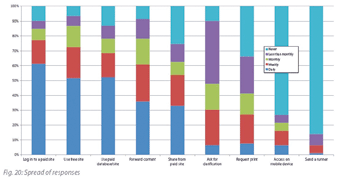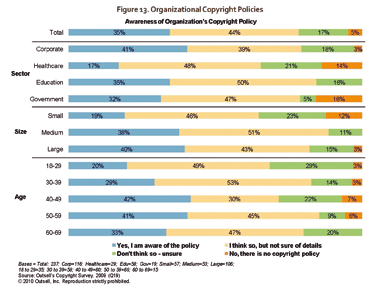
Copyright Compliance in Private Companies: Challenges & Solutions
“This is a great article. I have to share it with the R & D department.”
“Our sales will dramatically increase when we post this product review on our website.”
“I grabbed these free photos off the web. Maybe I should email them to our Australian office so they can include them in marketing materials.”
“I like to access the corporate intranet on my tablet to read daily press coverage.”
“It would be great if chapter three of this eBook could be used in the next training course for our financial team.”
These are just some of the ways people use and share published information in companies today. Collaboration is essential in modern, efficient organizations, and digital sharing of copyright-protected content is one of its major components. In this article, Victoriano Colodrón, Executive Director of RightsDirect, discusses the copyright compliance challenges businesses face as well as effective solutions to these challenges.
In the United States alone, 75 percent of employees surveyed by research firm Outsell in 2010 said they share content with team members every week, and in many cases, daily. Workers around the world are increasingly sharing information, particularly online content. A 2011 FreePint survey revealed that more than 40 percent of workers worldwide forward web content at least weekly.
The use of copyrighted works – in particular text and image-based works – is intensive and pervasive in most companies, and not only those with a strong research component. Employees need to use and share valuable information from print and digital sources for everything from research, marketing and public relations to training and product management. In today’s fast-paced, global working environment, employees increasingly rely on timely access to information in order to innovate, collaborate and stay ahead of the competition.
Organizations use many different types of content, including scientific and technical information, financial, legal and business information, statistics, news, graphs and photographs and other images. Employees may obtain this information from a variety of sources including scientific, technical and trade journals, books, magazines, newspapers, websites and blogs. Access is typically gained through subscriptions with publishers or agencies, from document delivery and press-clipping agencies, and from corporate intranets and the Internet.
Dealing with copyright compliance
What do employees need to do when they want to share a scientific article, a blog post, a photograph or statistical information? How can they find out whether specific content is copyright-protected or who the copyright owner is? Whom should they contact in their company if they have doubts about copyright protection or to secure the necessary permissions?

Spread of responses (Interaction with potentially copyrighted content in
the enterprise). From Copyright Policies and Practices 2011: Free Pint
Research Project, March 2011.
While employee copyright awareness is higher than even five years ago, studies show that most workers still lack sufficient awareness of their responsibilities under intellectual property (IP) laws, particularly when it comes to sharing digital content. Many believe that content available on the Internet can be shared without requesting permission. They either assume they can forward articles from journals they subscribe to, or they are unaware of whether – or how to – clear the necessary rights. The Outsell study revealed that 54 percent of knowledge workers surveyed either do not think about the need to obtain copyright permission when forwarding information, or are simply ambivalent.
The combination of low copyright awareness with fast and easy ways to access and share information has created one of the most important challenges facing companies today — copyright risk management. Low awareness can result in confusion, for example, about the exceptions and limitations to exclusive rights established in national copyright laws. These exceptions and limitations typically do not cover acts of exploitation by private companies for business purposes. This lack of awareness and understanding is especially apparent in companies with no specific copyright policy or no copyright compliance officer. Instituting a copyright policy and appointing, training and empowering someone to be responsible for copyright compliance matters can be a tall order for many businesses.
Even companies that try their best to protect the IP of third parties can experience difficulties in obtaining the necessary permissions for employees to share content legally. Obtaining permission from copyright holders can be a cumbersome and time-consuming process, especially if efficient, flexible licensing sources are not used. Businesses need to identify the works to be used, locate the relevant right owners or licensing agencies and, finally, acquire the rights. This entails time and money. Given the potentially thousands of different individual right holders from whom to obtain authorization, the multiple types of information, licensing and invoicing procedures involved, and the varying response times and levels of service, the scale of the challenge is enormous.
In many cases, obtaining the necessary authorization means interrupting business workflows and delaying the dissemination of information. Corporate researchers who need to share scientific articles online with their colleagues require authorization mechanisms that are quick and easy to use. In an ideal world, these researchers would have a license that pre-authorizes this type of content use.
For multinational corporations, having employees in different countries can further complicate copyright compliance, because IP rights are territorial in nature. A license that allows employees to share material across borders is therefore crucial. Subtle nuances in national copyright laws may have significant implications for business practices where copyrighted materials are concerned. In many cases, multinational corporations struggle to obtain uniform, global permissions, and instead have to deal with licensing agreements restricted to specific countries or groups of countries, offering different sets of rights for different territories and operated by organizations with diverging licensing and pricing mechanisms. As FreePint highlights in its 2011 report, “knowledge workers often assume that their internal subscriptions to databases and premium resources enable global access, which is not always the case based on the actual license agreement with the vendor.”

From the State of Copyright in the Digital Age – What is a Publisher to Do?
By Ned May, Outsell, February 22, 2010. Page 17.
Compliance solutions
The good news is that there are solutions to these challenges. The “copyright compliance toolkit” at the disposal of private firms can be summarized in three key concepts: education, information and efficient licensing mechanisms.
Businesses around the world that understand the value of respecting copyright, as well as the financial and reputational risks involved in copyright infringement, ensure their employees receive sufficient, appropriate and ongoing education on these matters. Whether through in-house training or training provided by external experts, it is important that courses be tailored to internal audiences. A broader, more committed approach to copyright education should also include a corporate copyright policy, as well as the appointment of a copyright compliance officer to ensure company-wide adherence to copyright procedures.
Licensing is perhaps the most important element of a successful copyright compliance strategy. Businesses have two main ways of clearing rights to use copyright-protected content: they can either obtain permission directly from each right holder or collectively from many different right holders via a single collective licensing broker. Collective licensing allows companies to simplify the permissions process by securing the required rights from one source. This can be done on a per use basis, or through a blanket or repertory type of license which is more popular among businesses.
While it is important for businesses to respect IP rights, it is also critical that copyright holders and their representatives provide licensing services that are easy to use and well adapted to the needs of corporate users. When the use of content is widespread, involving thousands of information sources and right holders, licenses that aggregate relevant rights prove to be a cost-effective solution. With this method, permissions are pre-cleared and available whenever the need to share the content arises, thus minimizing the risks of copyright infringement.
It is this kind of license that reproduction rights organizations offer to domestic corporate markets. Copyright Clearance Center (CCC) and its European subsidiary, RightsDirect, for example, provide a license that gives corporations the right to share content belonging to thousands of different copyright holders. Employees are granted a consistent set of rights for sharing information with co-workers in multiple territories. CCC and RightsDirect also offer free resources to help companies develop copyright policies of their own and to educate staff about copyright law.
Businesses thrive through collaboration and the exchange of knowledge, and this requires access to copyright-protected information. Clearing the rights to use this information can place a heavy burden on businesses. Fortunately there are simple and effective licensing solutions that enable companies to successfully rise to the copyright compliance challenge.
The WIPO Magazine is intended to help broaden public understanding of intellectual property and of WIPO’s work, and is not an official document of WIPO. The designations employed and the presentation of material throughout this publication do not imply the expression of any opinion whatsoever on the part of WIPO concerning the legal status of any country, territory or area or of its authorities, or concerning the delimitation of its frontiers or boundaries. This publication is not intended to reflect the views of the Member States or the WIPO Secretariat. The mention of specific companies or products of manufacturers does not imply that they are endorsed or recommended by WIPO in preference to others of a similar nature that are not mentioned.